Launching seeds is both enjoyable and fulfilling, perfect for beginners or seasoned gardeners seeking new experiences. Explore these 19 innovative seed starting concepts to enhance your gardening skills, elevate your plant cultivation, and foster robust growth. Delve into these easy methods to germinate your seeds and prepare them for flourishing!
Peat Pots for Eco-Friendly Seeds
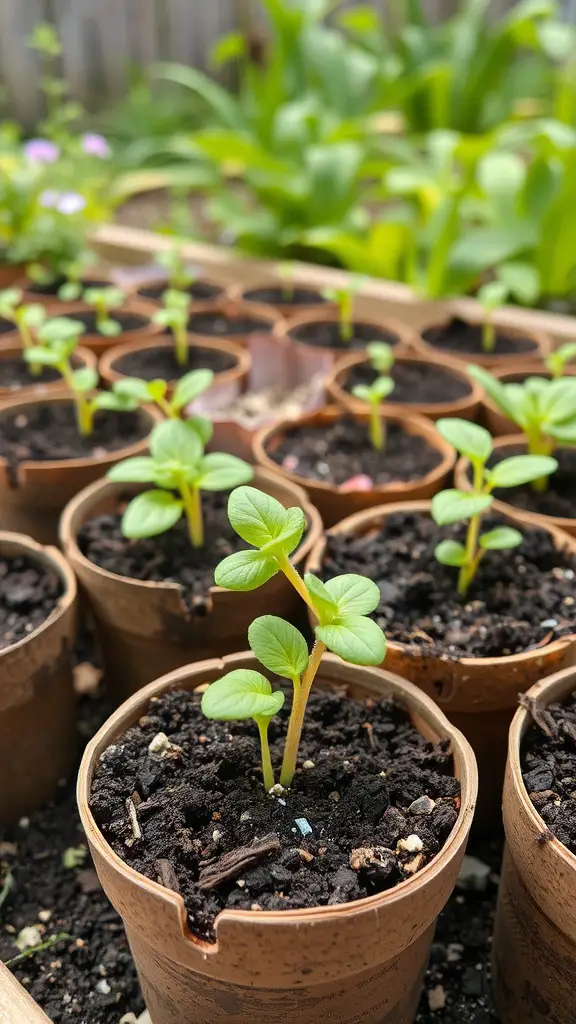
Peat pots remain an excellent choice for seed starting in 2025, particularly for eco-conscious gardeners. Crafted from compressed peat moss, these biodegradable pots nurture robust seedling growth while significantly reducing plastic consumption.
The picture showcases several young plants flourishing in peat pots. The pots’ gentle, natural colors beautifully contrast with the leaves’ bright green hues. Each small plant stretches upwards, ready to absorb sunlight and nourishment.
Peat pots simplify transplanting! Plant the whole pot directly into your garden when seedlings mature. This avoids root shock, encouraging robust growth. The pots decompose naturally, improving your soil as they do.
Begin by filling each peat pot with a premium seed-starting mix. Plant your seeds following the instructions on the seed packet. Water them carefully and place the pots in a warm, well-lit location. Monitor their progress, and before long, you’ll have a thriving garden. Your plants will have begun their life in these environmentally friendly containers!
Using Ice Cube Trays for Small Seeds

Starting seeds indoors using ice cube trays is a smart technique. The picture displays a tray packed with soil, showcasing emerging seedlings. Each section contains a small plant, simplifying management and growth observation.
Ice cube trays offer a perfectly sized space for individual seeds, making them incredibly useful. A standard tray works well for growing herbs or petite flowers. Just fill each section with potting mix, sow your seeds, and lightly water them. This method is still effective in 2025!
This technique saves space. Position the tray on a windowsill or any sunny area indoors. This guarantees your seedlings receive sufficient light. The transparent lid maintains humidity, acting like a small greenhouse.
Monitor your seedlings closely as they mature. Once robust, transplant them to bigger pots or your garden. Starting your gardening adventure this way is both enjoyable and rewarding!
Old Coffee Cups as Seed Holders
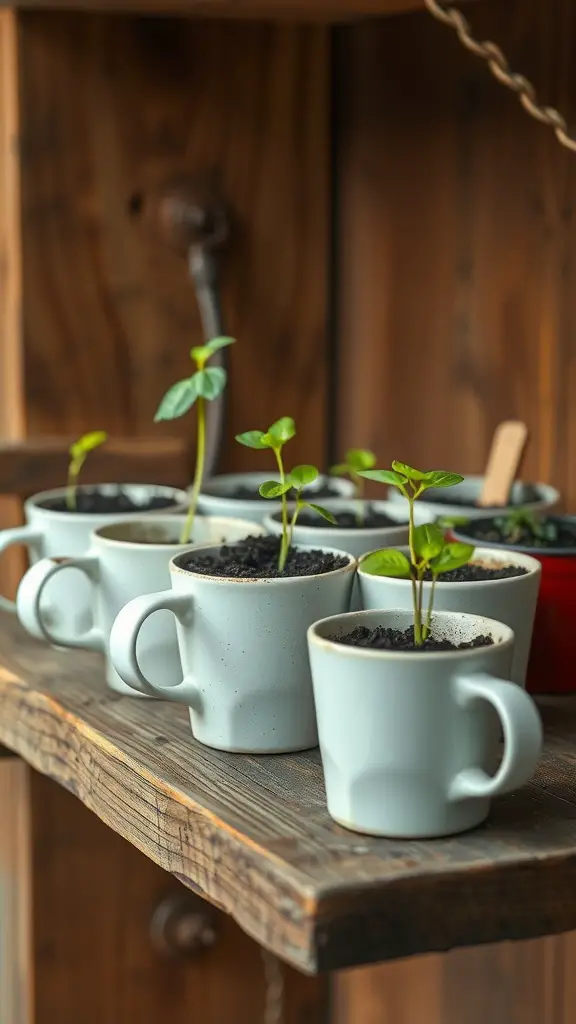
Repurposing used coffee cups as seed starters is a creative and eco-friendly gardening hack. These cups bring a unique, personalized feel to your garden. Plus, you’re giving a new life to something you’d normally discard.
This image presents a delightful assortment of vintage coffee cups. Each cup is repurposed, now holding soil and sprouting seedlings stretching towards the sunlight. It’s an inspiring example of how ordinary objects can be creatively reused. The cups, each with its distinct pattern, offer a unique narrative while nurturing new plant life.
Coffee cups are excellent for starting seeds, offering convenient portability. Easily relocate them to optimize sunlight exposure. Create drainage by simply adding a few holes to the bottom!
Begin by filling each cup with quality potting soil. Next, plant your seeds, following the directions on the seed packet. Water gently. Watch your seedlings sprout and grow into a tiny windowsill garden. This is an easy and rewarding way to begin your gardening adventure!
Plastic Containers for Seed Germination
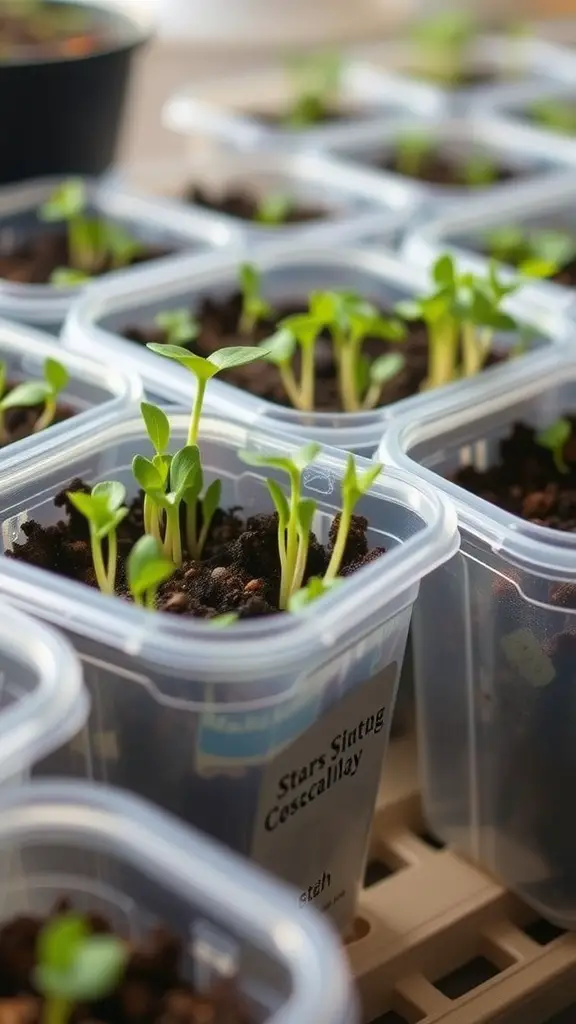
Starting seeds in plastic containers remains a highly efficient and convenient method in 2025. These containers offer a stable, regulated environment, fostering robust germination and early growth. The image showcases multiple compact plastic containers, each nurturing young seedlings emerging from the soil. Their small size is ideal for seed starting, optimizing space utilization.
The transparent plastic offers effortless seed growth monitoring. Easily observe moisture and determine optimal transplant timing. Its space-saving design allows multiple containers on windowsills or small tables. Ideal for beginners embarking on their gardening adventure in 2025.
Always create drainage holes in your plastic containers. This prevents excess water buildup, protecting your young plants. Repurpose old food containers or purchase seed-starting trays. Both options are great for jumpstarting your garden quickly!
Recycled Toilet Paper Rolls as Pots

Starting your garden with repurposed toilet paper tubes is an eco-friendly and easy method. These cardboard rolls offer the perfect size for nurturing young seedlings. They give them ample room to develop before transplanting them outdoors.
Sunlight streams through the window, illuminating a collection of toilet paper rolls. Inside, tiny seedlings sprout, their vibrant green leaves reaching upwards. This clever reuse transforms waste into a nurturing mini-greenhouse, perfect for starting new plants.
Creating these planters is simple! Cut the cardboard tubes in half. Next, fill them with soil suitable for planting. Now, sow your seeds. Water carefully and put them in a sunny location. When the young plants are bigger, transplant them to your garden or bigger containers.
This approach is both environmentally conscious and cost-effective. Furthermore, observing your seedlings flourish in these DIY containers provides a feeling of success. Collect your used cardboard tubes and begin your seed-starting journey!
DIY Seed Starting Mix Recipes

Starting seeds correctly is crucial for a thriving garden. Crafting your own seed starting mix is an enjoyable and budget-friendly approach. The picture displays different components for a personalized blend. A bowl contains a light, airy base, accompanied by seeds, nuts, and fresh herbs. These elements aid in nourishing your seeds during germination.
Creating your own seed starting mix is easy! Consider a few key ingredients. A simple recipe combines equal parts peat moss and vermiculite. This blend offers excellent aeration and moisture retention, ideal for delicate seedlings. For enhanced drainage, add some perlite.
Need a fast recipe? Ingredients: Combine 1 part peat moss, 1 part vermiculite, and 1 part perlite. Steps: Begin by blending peat moss and vermiculite in a sizable container. Slowly incorporate the perlite, mixing thoroughly for a consistent texture. This mix provides an excellent environment for seed growth.
Don’t hesitate to try other components! Some growers add a bit of compost for added nourishment. The key is a light, well-draining blend. This supports healthy seed development.
Using Eggshells for Seed Starters
Starting seeds in eggshells is a delightful and sustainable gardening method. The photo showcases tiny plants emerging from halved eggshells. These shells are neatly arranged in a carton, forming an attractive and functional setup. This is a great way to recycle and get your garden growing in 2025!
Why choose eggshells? Primarily, they’re biodegradable. When your seedlings are ready for transplanting, simply plant the whole shell. As the eggshell decomposes, it enriches the soil, providing valuable nutrients.
Begin by gently cracking the eggs, being sure to keep the shells intact. Thoroughly rinse the shells and allow them to fully dry. Next, fill each shell half with quality potting soil. Carefully plant your chosen seeds. Water them lightly, ensuring the soil remains consistently moist, but not waterlogged.
Watch your seedlings thrive! They’ll look adorable and benefit from the eggshells’ calcium. This boosts their overall health. Enjoy the satisfaction of repurposing kitchen waste into garden helpers. It’s a win-win for you and your plants in 2025!
Ready? Collect your eggs, unleash your creativity, and watch your young plants flourish!
Using Wooden Crates for Multiple Seedlings
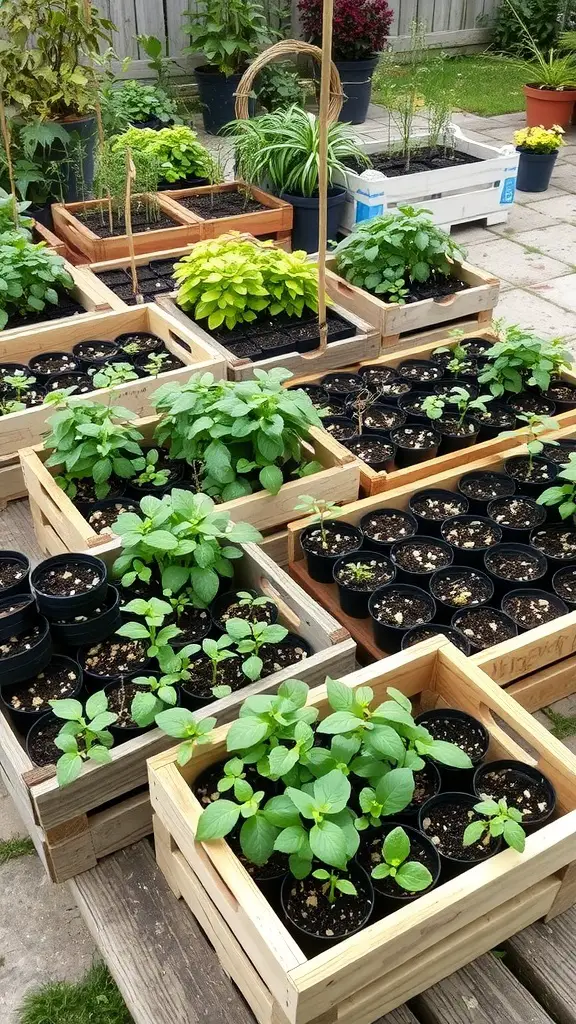
Wooden crates are a delightful and functional choice for starting numerous seedlings simultaneously. They offer generous space and effortless portability around your garden or patio. The image showcases several crates brimming with diverse young plants, each flourishing in its designated area.
These crates are excellent for seedling organization. Plant various seed types in separate crates for simpler garden management. They also ensure proper drainage, vital for robust plant development. The image displays herbs and flowers, highlighting the method’s adaptability. Consider using these crates for a well-organized and thriving garden in 2025.
These crates also boost watering efficiency. Their design ensures water goes straight to the plants, minimizing overwatering risks. Picture the delight of seeing your young plants flourish, knowing they’re in the perfect growing space!
Seed Starting in Jiffy Peat Pellets
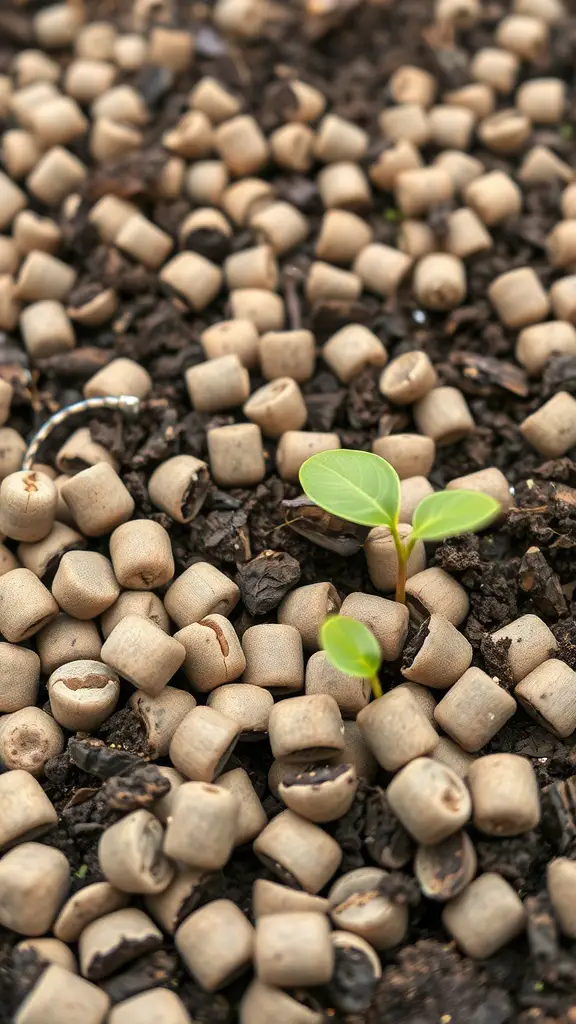
Thinking about starting seeds? Jiffy peat pellets are a great choice. These small, compressed peat moss disks expand when watered. They offer a convenient and comfortable start for your seeds.
Observe these seed pellets nestled in rich soil. Notice the delicate green seedlings emerging. Isn’t it inspiring to witness new life begin? It’s a beautiful illustration of how care and dedication can lead to growth.
These seed pellets simplify seed organization and guarantee optimal moisture levels. Transplanting becomes effortless: move seedlings directly to your garden, minimizing root disturbance. This ensures a seamless transition and healthier plant establishment.
Begin by hydrating the pellets in lukewarm water. Watch them swell! Next, nestle your seeds into the pre-made indentations. Maintain consistent moisture and warmth. Before long, tiny sprouts will emerge, poised to flourish into something extraordinary!
Sowing Seeds in Muffin Tins
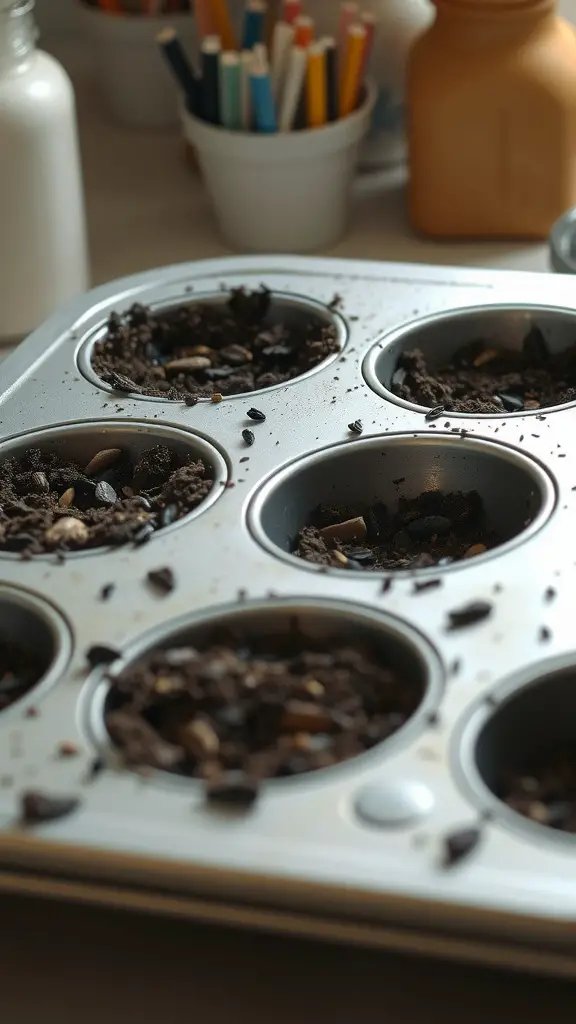
Starting your garden? Try sowing seeds in muffin tins! It’s a simple and effective technique. Each compartment provides ample growing space for individual seeds. The image showcases a muffin tin, filled with soil and prepared for planting, making it garden-ready.
Muffin tins are excellent for organizing various seed types. Labeling each compartment simplifies managing diverse plant varieties. Their metal construction also promotes effective drainage, which is beneficial for seed starting.
Begin by filling each section with potting soil. Leave a bit of space at the top for growth. Next, plant your seeds following the directions on their packets. Water gently and place the container in a sunny location.
Once seedlings emerge, transplanting them to bigger pots or your garden is simple. This approach saves space and improves seed-starting management.
Creating a Mini Greenhouse with Plastic Wrap
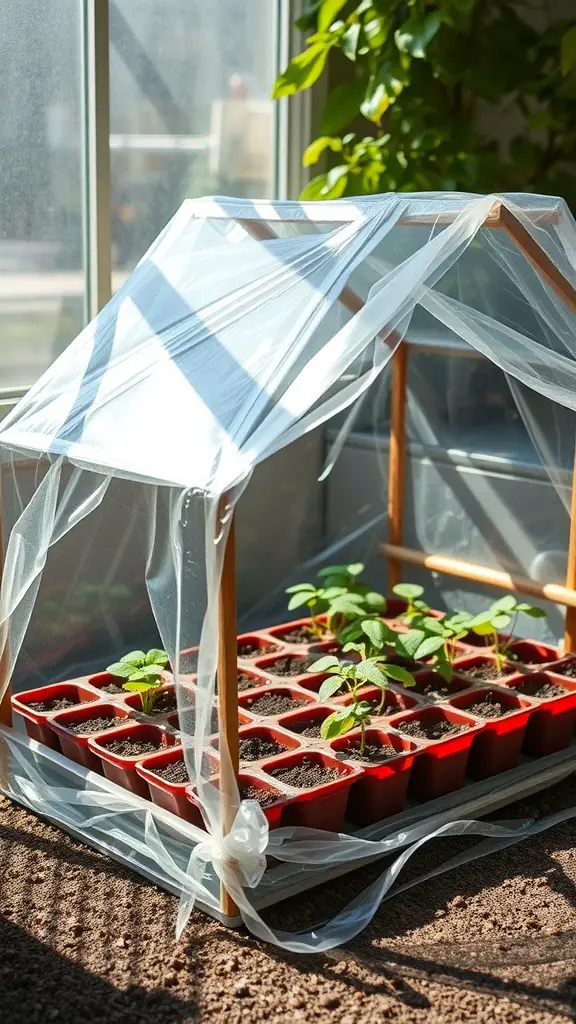
Building a small greenhouse is an easy and efficient method for growing seedlings. The picture showcases a delightful setup using wood frames and plastic sheeting. This design fosters a warm, moist climate, perfect for starting seeds.
Plastic wrap creates a protective barrier, retaining warmth and humidity. This is particularly beneficial during colder seasons, maximizing your plants’ growth potential. Inside the greenhouse, red planting trays are filled with fertile soil. Young plants are actively germinating within them.
Crafting your own mini greenhouse is simple! Begin with some wooden supports or a compact frame. Enclose it with transparent plastic sheeting, securing it tightly to form a snug environment for your young plants. Position your greenhouse in a bright, sunny location. The sunlight will naturally heat the interior, encouraging robust growth.
This technique is both useful and promotes active participation in gardening. Observing your plants thrive in this supportive setting is truly rewarding, enhancing the pleasure of gardening!
Berry Containers for Seedling Growth
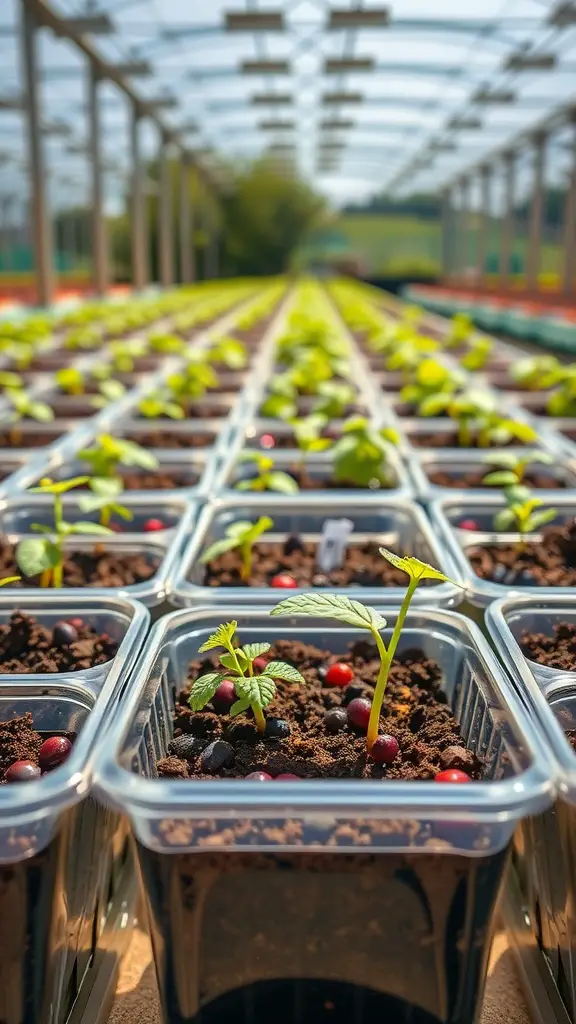
Considering seed starting? Berry containers offer a surprisingly effective solution. Their compact size, light weight, and excellent drainage create an ideal environment for nurturing young seedlings.
The image showcases neat rows of berry containers. Each container is filled with soil and sprouting seedlings. The bright green leaves contrast sharply with the dark soil, a sign of vigorous growth. These containers make it easy to monitor each seedling’s development, particularly useful when testing various berry types. This setup is ideal for small-scale berry cultivation and observation.
Berry containers offer a fantastic way to recycle! Instead of discarding them, give them a new life in your garden. Simply create drainage holes at the base and fill them with premium potting soil.
Observe your seedlings’ progress as they mature. Ensure they receive ample sunlight and gentle watering. When they’re sufficiently developed, transplant them to your garden or bigger containers. This approach conserves space and provides each seedling with an ideal environment during its initial growth phase.
Utilizing Plastic Bottles for Seed Starting
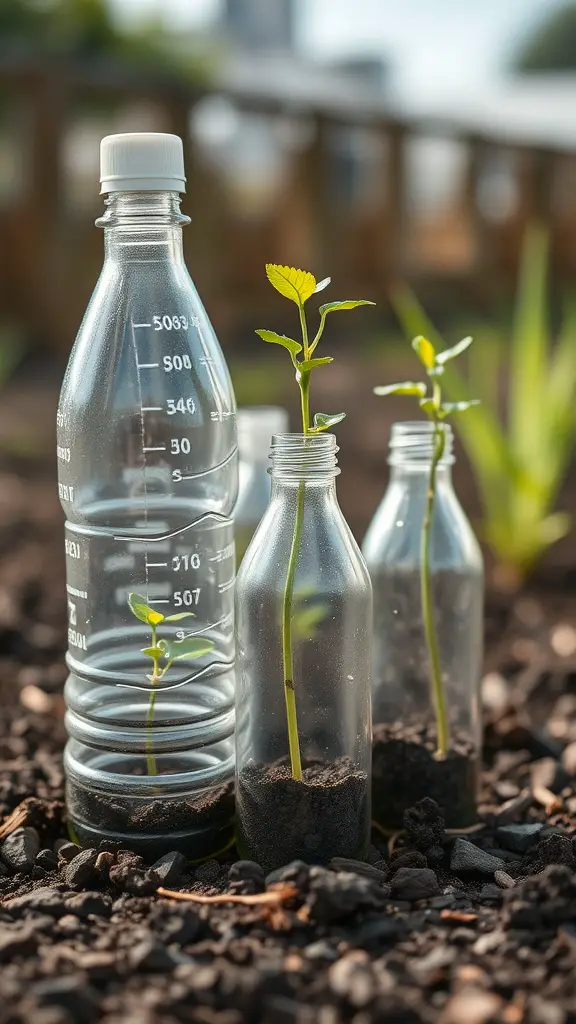
Repurposing plastic bottles for starting seeds is both innovative and environmentally conscious. The image showcases bottles cleverly converted into miniature greenhouses, nurturing young seedlings. This approach is practical and significantly contributes to recycling efforts and waste reduction.
Begin by cleaning your plastic bottles thoroughly and cutting them in two. The bottom section will hold your soil and seeds. The top half can be inverted and placed over the bottom, acting like a mini-greenhouse. This setup traps humidity and warmth, ideal for sprouting seeds.
These compact greenhouses offer a transparent view of your plants’ progress. Witnessing root development is incredibly rewarding. Ensure proper drainage by creating holes at the base. Monitor moisture carefully for optimal growth.
This is a simple and enjoyable project for all ages. Plastic bottles offer a nurturing start for seeds, whether you’re growing vegetables, herbs, or vibrant flowers. It’s a great way to recycle and garden!
Starting Seeds in a Repurposed Shoe Box

Starting seeds in a recycled shoe box is a smart and environmentally conscious choice. This cost-effective approach breathes new life into discarded items.
This image showcases a clever upcycling project: a shoe box repurposed as a seed starter. Tiny seedlings are emerging from the soil, stretching towards the light. The soil appears fertile, offering essential nourishment for their early growth.
Crafting your own seed starter is easy! Grab an old shoe box and create drainage holes at the base. Fill it with quality potting soil. Plant your seeds, following the packet’s guidelines. Place the box in a warm, sunny location and water regularly. This straightforward method can result in a flourishing garden in 2025!
Once your seedlings mature, choose to transplant them to bigger pots or plant them straight in your garden. Reusing a shoe box is cost-effective and eco-friendly, a perfect start to your gardening journey in 2025.
Plastic Clamshell Containers for Seedlings

Want an easy method for starting seeds? Plastic clamshell containers are a great choice. You can easily find these containers; they often come with store-bought produce. They create an ideal environment for healthy seedling growth.
The image showcases neat rows of young seedlings thriving in transparent containers. This clear design is advantageous, enabling easy monitoring of moisture and light conditions without disrupting the delicate plants. Furthermore, the plastic material aids in retaining warmth, providing a snug and favorable environment for these emerging sprouts.
Clamshell containers offer more than just convenience. They present an excellent opportunity for material recycling. Once you’ve enjoyed your berries or salad, repurpose the container for your garden. Simply add potting soil, plant your seeds, and nurture their growth!
Ensure your container has drainage holes if it lacks them. This simple action prevents overwatering, protecting your young plants. Proper care will result in a thriving mini-garden, ready for transplanting outside.
Utilizing Windowsills for Natural Light

Windowsills offer an ideal location to germinate your seeds. These spots provide young plants with vital natural sunlight, crucial for robust development. The picture displays a seedling tray enjoying the sun’s rays, stretching towards the light in anticipation of growth.
A windowsill is a great, easy way to give your seedlings the light they need. Many plants flourish with bright, indirect sunlight, which windows often provide. Place your seed trays here to use space efficiently and boost your plants’ early growth.
Effortlessly watch your seedlings thrive indoors. Remember to rotate them regularly to prevent lopsided growth. This simple action promotes even development, enhancing your gardening satisfaction.
Paper Towel Method for Germination
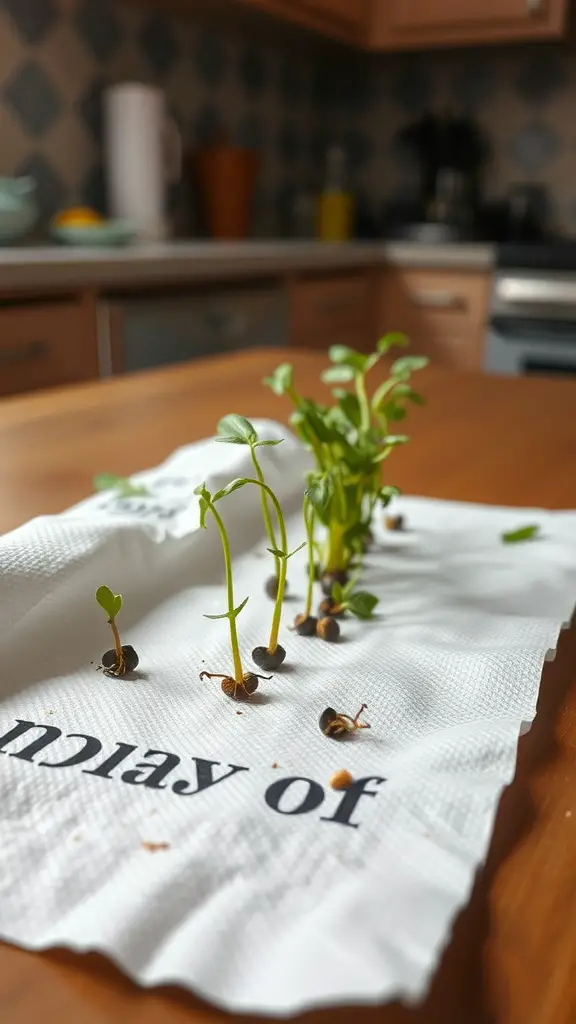
Germinating seeds using the paper towel method is easy and yields great results. The image displays seeds sprouting on a moist paper towel, illustrating the beginning of their growth journey. This technique remains a popular choice in 2025 for its simplicity and effectiveness.
This technique leverages a humid setting to boost seed germination before soil planting. The paper towel retains moisture and promotes air flow, vital for sprouting. Witness the fragile stems emerge, prepared for growth.
Ready to begin? You’ll need seeds, a paper towel, and a plate or bag. Dampen the paper towel and spread your seeds on half. Fold the towel to keep the seeds moist. Place it in a warm area and check daily. Soon, you’ll spot small green sprouts!
Seed Starting with Hydroponic Systems
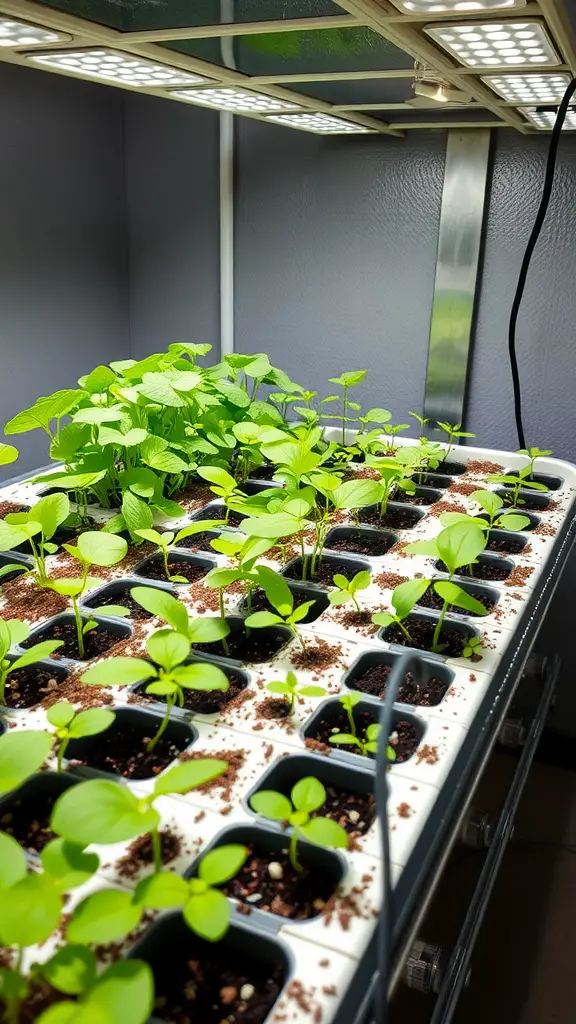
Initiating seed growth using hydroponics offers an engaging and efficient method for indoor gardening. The picture showcases a setup where young plants flourish beneath powerful LED illumination. Notice the vivid green foliage stretching towards the light, a clear sign of robust development.
Hydroponics involves cultivating plants without soil, minimizing pest and disease issues. This technique provides precise control over plant nutrition. As seen in the image, each seedling is individually housed in a small cup, simplifying progress tracking.
Begin your hydroponic seed journey with a setup featuring a water reservoir and pump. Select a growing medium such as coconut coir or rock wool. Add nutrient-rich water to the reservoir. Ensure the pump effectively circulates water to nourish your seedlings.
Monitor the lighting carefully. The LED grow lights give your plants the energy for robust growth. Adjust the height of the lights to prevent leaf burn, ensuring adequate light exposure.
Using a Seedling Heat Mat for Warmth
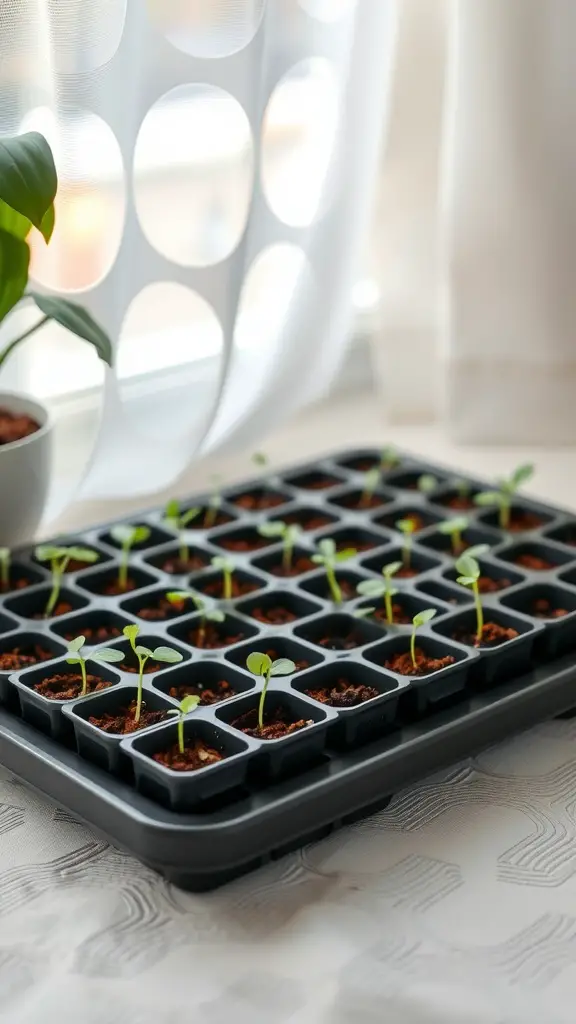
Kickstart your garden by starting seeds indoors! Seedling heat mats are a fantastic tool. They deliver consistent, gentle warmth. This warmth speeds up germination and promotes robust seedling development.
The image showcases a tray brimming with seedling pots, each holding vibrant young plants. They’re strategically placed by a sun-drenched window, maximizing their access to sunlight. A heat mat underneath provides consistent warmth, fostering ideal germination conditions. This carefully designed environment is excellent for cultivating these fragile seedlings.
Optimal soil temperature accelerates seed germination. A seedling heat mat maintains consistent warmth, even in cooler environments. This is especially beneficial for seeds that require warmer soil to flourish.
Once your seeds are sown, position the tray on the warming mat. Regularly check soil moisture, as heat accelerates drying. With proper attention, a thriving garden awaits!